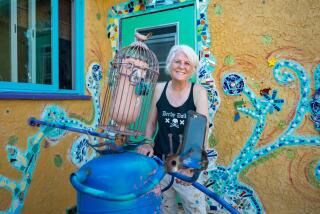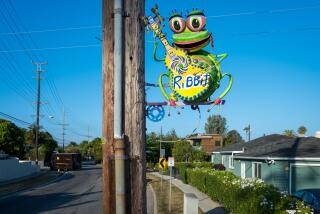Di Suvero and steely resolution
Mark di Suvero walks up to one of his elephantine steel sculptures and gives it a good whack with a rubber-headed mallet. A sound like a Tibetan gong reverberates through L.A. Louver Gallery in Venice. “It sounds different depending on where you hit it,” he says, and demonstrates the point furiously with a few more bangs. Then he gives a shove to the huge, rusted steel arabesque, and it twirls atop its steel base like a child’s toy.
With a tousle of hair as white as a cloud, the 75-year-old Di Suvero is all the more impressive in this athletic display for the fact that he can walk only with the aid of crutches because of a crippling injury from almost 50 years ago. Yet his enthusiasm is infectious, and in no time he has persuaded a visitor to swing like a child on the rubber seat suspended from a 14-foot-high, cantilevered I-beam.
“Sometimes I think Mark di Suvero is Peter Pan in disguise,” says art critic Phyllis Tuchman. “He wants people to interact with his powerful steel sculptures, not just look passively at them. Watching someone push an I-beam that moves or swing on a dangling tire or platform brings joy to his face.”
Outspoken activist
Considered to be a leading contemporary sculptor, Di Suvero is celebrated for the participatory nature of his imposing sculptures. In his eponymous show, all of the sculptures on view through Saturday at L.A. Louver Gallery, whether small, medium or large, have movable parts that spin, tip and dip. The calligraphic drawings in black ink on paper seem to dance with movement. This show brings him back to L.A., where he lived in the mid-’60s and created some of his first monumental sculptures. “There is always that element of having people interact with the work,” he insists. For Di Suvero, the political is personal, an attempt to increase individual awareness in a viewer.
When “Declaration,” his 6-foot sculpture of steel I-beams, was erected atop a hillock at the end of Windward Avenue in Venice in 2001, he told Venice magazine, “I would like to think that . . . it expands your sense of possibility of spirit.” A few months later it was used as a gathering place for “Where Are the Voices?” -- readings by writers responding to the Sept. 11 tragedy. Last month, Paul Vangelisti, chairman of Otis College of Art and Design’s graduate writing program, and Beyond Baroque Director Fred Dewey co-published a book, also titled “Declaration,” collecting the poetry and prose from that evening and illustrating it with photographs of Di Suvero’s sculpture.
Di Suvero has long been an outspoken political activist, and that was not the first time his sculpture had been the locus of such an event. In 1966, he erected his 55-foot-tall Peace Tower on a vacant lot on the corner of Sunset and Crescent Heights boulevards. A protest against the Vietnam War, it was designed with a platform that would hold hundreds of 2-by-2-foot paintings sent by artists wanting to join the protest, including such well-known figures as Robert Motherwell, Donald Judd and Roy Lichtenstein. (The works later were auctioned to raise money to fund the protest.)
During the three months of its existence, the tower and its artists -- including Di Suvero, Irving Petlin, Lloyd Hamrol and Judy Gerowitz, who soon after changed her last name to Chicago -- were attacked physically and verbally. “The Marines and the police beat people up. They wouldn’t let us hang the paintings,” Di Suvero recalls heatedly.
The tower became common ground for those in L.A. who were against the war. “It was a colonialist war that happened and is happening again,” Di Suvero insists. The events attracted the attention of a younger generation of artists in 2006, when the Peace Tower was resurrected by Rirkrit Tiravanija with Di Suvero at the Whitney Museum of American Art’s Biennial exhibition as a protest against the war in Iraq.
Di Suvero says his political outlook shifted in the early ‘60s when he became involved in Park Place, the first artists’ cooperative gallery to open in a loft space in the industrial area of New York’s SoHo. “Before Park Place, it was all subjective, all about how a single artist feels. When we worked at Park Place, it was so different. We played music. Whoever sold anything, we shared the money. Totally radical. We were crazy.” It was run by Paula Cooper, who now is Di Suvero’s dealer in New York.
Outlast
Di Suvero’s politics took its toll. After he was arrested and jailed twice for his protests against the Vietnam War, he moved in 1971 to Europe and settled in Chalon Sur Saone, France, where he was able to build his steel sculptures in a shipyard and live on an abandoned oil tanker. “I always wanted to work in steel, but that cost a lot of money. One of the things I never thought was that I would outlast U.S. Steel. They wouldn’t even sell me steel because I was too small.” By 1975, he was the first living artist to have his work exhibited in the Tuileries garden in Paris.
Di Suvero’s strong convictions are in keeping with his namesake -- he was born Marco Polo di Suvero in Shanghai, China, where his submarine commander father was posted. He was reared in Oakland, where he began taking woodworking classes at a small arts and crafts school at the age of 8 and also took sculpture classes at UC Berkeley, where he completed a degree in philosophy. He moved to New York in 1957 and three years later combined enormous timbers with chains in his debut show at the Green Gallery. It was met with critical praise, but his career was halted by a terrible accident.
Riding on top of an elevator with a load of lumber, he was crushed when the elevator failed to stop at the top. His back was broken, and he spent the next two years in a wheelchair. He was only 27. He was told that he would never walk. “I was very lucky, and the capacity of the human body for rehabilitation means you have to try different things.”
He put an asbestos apron on his lap and began welding. Though he could not walk without crutches, he learned how to operate a crane and started composing sculptures of I-beams and welded metal. He told art critic Barbara Rose, “The crane is my paintbrush.”
In 1965, he showed enormous timber sculptures at the Dwan Gallery in Westwood, and for the next few years he lived in West Hollywood, working on the Peace Tower and other sculptures. In 1967, his work was included in the exhibition at the L.A. County Museum of Art, “American Sculpture of the Sixties.” After moving to Europe, he intended to return to L.A. but wound up establishing his primary studio in Long Island City, N.Y. Married to Kate Levin, cultural affairs commissioner of New York City, he has a 13-year-old daughter and the schedule of an adolescent.
His political and social inclinations have continued unabated, and adjacent to his East River studio, he has reclaimed an area of industrial blight as Socrates Sculpture Park. Through his nonprofit Athena Foundation and the financial and political support of New York, artists are invited to create works in the park alongside Di Suvero’s work.
Asked about the source of his desire to help others, especially artists, Di Suvero says, “The heart of art is the search for form that is electrifying, that gives life to our vision. This is the language of emotion. Anesthetic is to kill feeling. Aesthetic is the opposite, aesthetic is feeling. The thing that is most important is the dream, the vision for what doesn’t exist that could exist. You get that from other artists.”
More to Read
The biggest entertainment stories
Get our big stories about Hollywood, film, television, music, arts, culture and more right in your inbox as soon as they publish.
You may occasionally receive promotional content from the Los Angeles Times.










